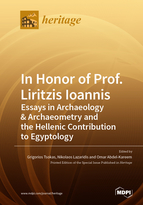In Honor of Prof. Liritzis Ioannis: Essays in Archaeology & Archaeometry and the Hellenic Contribution to Egyptology
A special issue of Heritage (ISSN 2571-9408).
Deadline for manuscript submissions: closed (31 August 2021) | Viewed by 40264
Special Issue Editors
Interests: development of archaeological prospection data acquisition; mediterranean geoarchaeology; processing and interpretation techniques; potential fields theory and practice and complex attributes analysis in archaeological exploration geophysics
Special Issues, Collections and Topics in MDPI journals
Interests: ancient Egypt; ancient Greece; ancient Near East; ancient languages; ancient literature; egyptology; fieldwork
Interests: analysis and conservation of archaeological and culture heritage objects; conservation sciences; restoration of material culture; textiles; organic; inorganic materials; cultural management
Special Issue Information
Dear Colleagues,
We are delighted to invite you to contribute to a Special Issue of HERITAGE, an Open Access multidisciplinary peer-reviewed journal published bi-annually by MDPI.
The title of this Special Issue is Essays in Archaeology & Archaeometry and the Hellenic Contribution to Egyptology and it is to honor Professor Ioannis Liritzis in the occasion of his retirement from the University of the Aegean and his major support of Egyptology in Greece and internationally. The interdisciplinary field of Heritage culture, archaeology, history of art, coupled with natural sciences is undoubtedly a breakthrough in the advancement of cultural heritage studies. Regional development of heritage studies becomes of particular interest for SE Mediterranean and with focus in Egypt which is rich in novel results coming from these disciplines which converge to the higher level of knowledge from prehistory to historical times.
Topics of interest include all Cultural Heritage and Archaeology subjects including conservation focused in Egypt and SE Mediterranean, such as:
- Field archaeology-Surveys
- Historical & archaeological studies of material culture
- Historical interactions with Greece, Egypt and the E.Mediterranean
- Archaeometry
- Archaeoastronomy
- Geoarchaeology and geosciences
- Digital archaeology
- Paleoanthropology
- Conservation & restoration of antiquities
- Environmental archaeology and palaeoclimates
- Marine archaeology and preservation of marine objects
Articles are encouraged to get submitted within the period of 1st June to 30th August 2021.
We anticipate that this volume will make a significant contribution to the field.
Please do not hesitate to contact us.
Prof. Dr. Grigorios Tsokas
Prof. Dr. Nikolaos Lazaridis
Prof. Dr. Omar Abdel-Kareem
Guest Editors
Manuscript Submission Information
Manuscripts should be submitted online at www.mdpi.com by registering and logging in to this website. Once you are registered, click here to go to the submission form. Manuscripts can be submitted until the deadline. All submissions that pass pre-check are peer-reviewed. Accepted papers will be published continuously in the journal (as soon as accepted) and will be listed together on the special issue website. Research articles, review articles as well as short communications are invited. For planned papers, a title and short abstract (about 100 words) can be sent to the Editorial Office for announcement on this website.
Submitted manuscripts should not have been published previously, nor be under consideration for publication elsewhere (except conference proceedings papers). All manuscripts are thoroughly refereed through a single-blind peer-review process. A guide for authors and other relevant information for submission of manuscripts is available on the Instructions for Authors page. Heritage is an international peer-reviewed open access monthly journal published by MDPI.
Please visit the Instructions for Authors page before submitting a manuscript. The Article Processing Charge (APC) for publication in this open access journal is 1600 CHF (Swiss Francs). Submitted papers should be well formatted and use good English. Authors may use MDPI's English editing service prior to publication or during author revisions.






